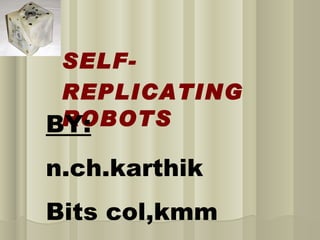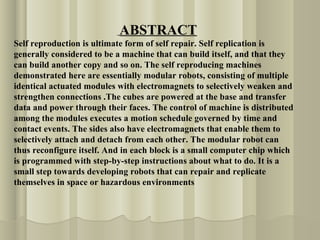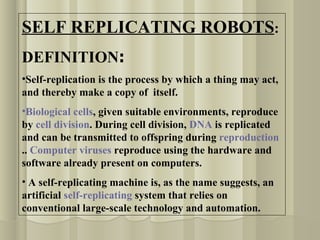selfrelfecting robotos
- 2. ABSTRACT Self reproduction is ultimate form of self repair. Self replication is generally considered to be a machine that can build itself, and that they can build another copy and so on. The self reproducing machines demonstrated here are essentially modular robots, consisting of multiple identical actuated modules with electromagnets to selectively weaken and strengthen connections .The cubes are powered at the base and transfer data and power through their faces. The control of machine is distributed among the modules executes a motion schedule governed by time and contact events. The sides also have electromagnets that enable them to selectively attach and detach from each other. The modular robot can thus reconfigure itself. And in each block is a small computer chip which is programmed with step-by-step instructions about what to do. It is a small step towards developing robots that can repair and replicate themselves in space or hazardous environments
- 3. DEFINITION OF ROBOTICS: Robotics is the science and technology of how robots are made and function via electronic and mechanical processes. It is also about understanding the software applications that control their movements. Robots are essentially machines that perform tasks.
- 4. SELF REPLICATING ROBOTS: DEFINITION: âĒSelf-replication is the process by which a thing may act, and thereby make a copy of itself. âĒBiological cells, given suitable environments, reproduce by cell division. During cell division, DNA is replicated and can be transmitted to offspring during reproduction .. Computer viruses reproduce using the hardware and software already present on computers. âĒ A self-replicating machine is, as the name suggests, an artificial self-replicating system that relies on conventional large-scale technology and automation.
- 5. ïą It is unlikely that this would all be contained within a single monolithic structure, but would rather be a group of cooperating machines that is capable of manufacturing all of the machines. ïąThe factory needs production of mining robots to collect raw materials, construction robots to put new machines together, and repair robots to maintain itself against wear and tear, all without human intervention or direction. ïąSelf-replicating machine needs the capacity to gather energy and raw materials, process the raw materials into finished components, and then assemble them into a copy of itself ïąThe advantage of such a system lies in its ability to expand its own capacity rapidly and without additional human effort.
- 6. ïąSelf-replicating machine needs the capacity to gather energy and raw materials, process the raw materials into finished components, and then assemble them into a copy of itself ïą The advantage of such a system lies in its ability to expand its own capacity rapidly and without additional human effort.
- 7. SELF REPLICATING MACHINES REQUIRE: âĒConstruction materials âĒManufacture of new parts âĒConsistent power source âĒProgramming the new members
- 8. Theory: Research by John von Neumann established that one common form of a replicator has several parts: ïA genome, a compact, usually error-resistant representation of the replicator's stored algorithm. Biologically, this is DNA. ïA specialized set of mechanisms to copy and repair the genome, using resources gathered by the body. Biologically, this is something like transcriptase. ïA body, which gathers resources and energy, and interprets a stored algorithm. Biologically, these are ribosomes.
- 9. A self-reproducing computer program In computer science a self-reproducing computer program is a computer program, that, when executed, outputs its own code. An example in the Python programming language: a='a=%s;print a%%`a`';print a%`a`
- 10. CLASSIFICATION OF SELF REPLICATING ROBOTS: Recent research has begun to categorize replicators, based on the amount of support they require. âĒNatural replicators have all or most of their design from nonhuman sources. Such systems include natural life forms. âĒAutotrophic replicators can reproduce themselves "in the wild". They mine their own materials. It is conjectured that non-biological autotrophic replicators could be designed by humans, and could easily accept specifications for human products. âĒSelf-reproductive systems are conjectured systems which would produce copies of themselves from industrial feedstocks such as metal bar and wire. âĒSelf-assembling systems are assemble copies of themselves from finished, delivered parts.
- 11. Design consideration The design phase of the replicators is very broad. A comprehensive study to date has identified 137 design dimensions grouped into a dozen separate categories, including: (1) Replication Control, (2) Replication Information, (3) Replication Substrate, (4) Replicator Structure, (5) Passive Parts, (6) Active Subunits, (7) Replicator Energetics, (8) Replicator Kinematics, (9) Replication Process, (10) Replicator Performance, (11) Product Structure, and (12) Evolvability.
- 12. Construction: ï§A self replicating robot which has been developed recently contains a series of modular cubes called "molecubes" each containing identical machinery and the complete computer program for replication.
- 13. âĒThe cubes have electromagnets on their faces that allow them to selectively attach to and detach from one another, and a complete robot consists of several cubes linked together. âĒEach cube is divided in half along a long diagonal, which allows a robot composed of many cubes to bend, reconfigure and manipulate other cubes. For example, a tower of cubes can bend itself over at a right angle to pick up another cube.
- 16. Base plate that supplies energy to cubes.
- 17. WORKING PRINCIPLE: ï Replication starts with , the stack of cubes bending over and sets its top cube ï Then it bends to one side or another to pick up a new cube and deposit it on top of the first ïBy repeating the process, one robot made up of a stack of cubes can create another just like itself. Since one robot cannot reach across another robot of the same height, the robot being built assists in completing its own construction.
- 19. APPLICATIONS OF THE SELF REPLICATING ROBOTS ïŽ Terrestrial Applications: An Intelligent Earth-Sensing Information System ïŽ A new primitive cell state in the system to permit signals to cross without interference called "wire-crossing" organ can be devised using only the self replicating cell types ïŽ Studies of the flow of excitation in heart tissue, the dispersal of medicinal drugs, and pattern recognition ïŽ Cell spaces also have been investigated as abstract mathematical objects where one tries to determine whether from every mathematical pattern all other patterns can be attained, and whether there are some patterns not attainable at all by means of the transition function, and various other specialized questions.
- 20. CONCLUSION ïŽ Self-reproduction is the ultimate form of self- repair. We see that robotic systems are becoming more complex, and in some cases like space exploration, they need to sustain operation for long periods of time without human assistance. ïŽ If you send a robot to Mars, for example, and it breaks, there is little you can do. But if instead of sending a fixed robot you send a robot with a supply of modules, then that robot may be able to self-repair and even make more and possibly different robots if the mission needs change unexpectedly.






















